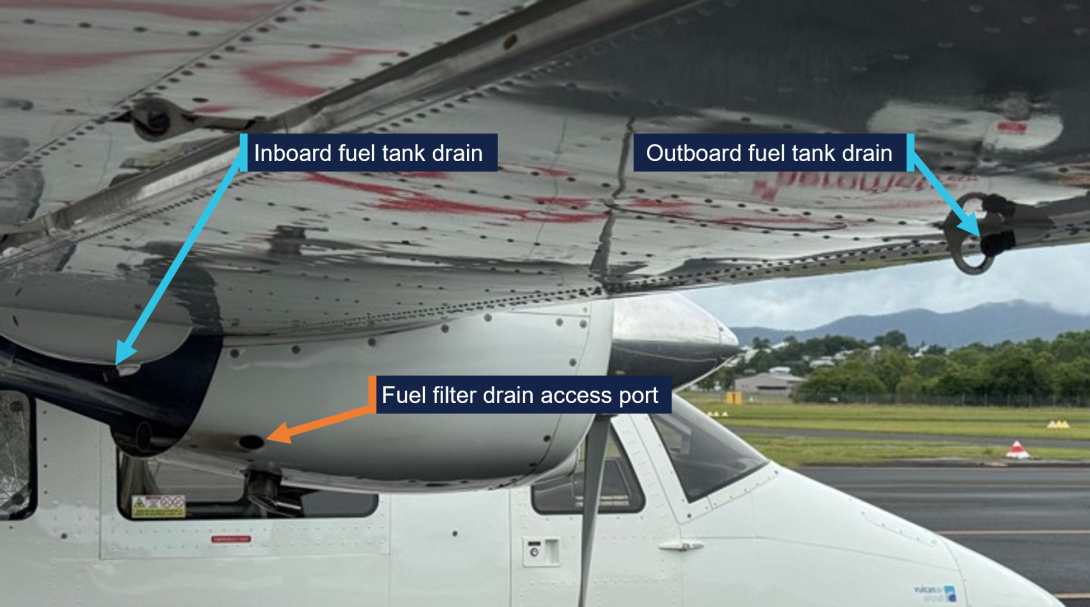What happened
On 14 February 2025, the crew of a Vulcanair P.68C was undertaking a dual instructional flight from Archerfield to Sunshine Coast Airport, Queensland. Around 1215 local time, about 45 minutes after departing from Archerfield, the crew reported both engines began surging, with an associated loss of power. Subsequently, the right engine shut down completely. Selection of the electric fuel (boost) pump as part of the crew’s emergency response checklist actions restored operational power to both engines, after which the crew elected to conduct a diversion to Caloundra where they made a normal approach and landing.
During the flight, the crew had identified a significantly higher than expected fuel consumption, which prompted a close examination of the aircraft’s fuel systems after landing. This examination found that both left and right fuel filter drains were in the open state, with fuel actively draining from both.
The aircraft has 6 fuel system drains – 4 under‑wing drains associated with the long‑range fuel tanks and 2 fuel filter drains positioned within the engine nacelles and accessed via a small circular port. All drains are opened routinely during pre‑flight inspections and must be re‑closed by rotating after fuel samples are taken. The fuel filter drains are the ‘Curtis‑T’ style valve, which can be locked in the open position and are only visible through the nacelle access port.
Figure 1: P.68 fuel drain locations (right wing)

Source: Aircraft operator, annotated by the ATSB
Unlike the fuel tank drains, which flow fuel directly from the tank sumps, the filter drains will not continuously flow fuel if the cockpit fuel selector is in the OFF position. In this position, the filter housing will empty of fuel, but no further fuel will drain until the fuel selectors are moved away from the OFF position during engine start up and flight operations.
During the operator’s discussions with crew, it was concluded that during the pre‑flight checks on 14 February, the filter drains were likely left in the open position after fuel samples were taken. Fuel loss from the drains after tank selection and engine start would likely not have been evident to the crew due to the outboard port locations and from the fuel atomising effects of propeller thrust.
Safety action
Following the occurrence and subsequent internal investigation, the aircraft operator undertook a range of safety actions aimed at reducing the potential for similar incidents. These included:
- company‑wide safety briefing on the event
- Notice to Air Crews (NOTAC) issued
- Flight Crew Operations Manual (FCOM) and Quick Reference Handbook (QRH) updates to include checks on fuel selectors pre‑flight and system behaviour with selectors OFF
- scenario‑based training for new pilots.
Safety message
Operators and crew of all aircraft equipped with fuel sampling drains must ensure they are familiar with the operation and behaviour of the drains when conducting routine pre‑flight fuel system checks. To ensure they are closed and secure before flight, particular attention should be paid to enclosed drains, or those that may not flow freely due to fuel system configuration settings.
About this report
Decisions regarding whether to conduct an investigation, and the scope of an investigation, are based on many factors, including the level of safety benefit likely to be obtained from an investigation. For this occurrence, no investigation has been conducted and the ATSB did not verify the accuracy of the information. A brief description has been written using information supplied in the notification and any follow-up information in order to produce a short summary report, and allow for greater industry awareness of potential safety issues and possible safety actions.


